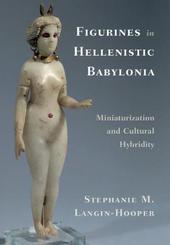
|
Figurines in Hellenistic Babylonia: Miniaturization and Cultural Hybridity
Hardback
Main Details
| Title |
Figurines in Hellenistic Babylonia: Miniaturization and Cultural Hybridity
|
| Authors and Contributors |
By (author) Stephanie M. Langin-Hooper
|
| Physical Properties |
| Format:Hardback | | Pages:350 | | Dimensions(mm): Height 260,Width 186 |
|
| Category/Genre | Ancient and classical art BCE to c 500 CE
Sculpture |
|---|
| ISBN/Barcode |
9781108488143
|
| Classifications | Dewey:738.82 |
|---|
| Audience | | Professional & Vocational | |
|---|
| Illustrations |
Worked examples or Exercises; 1 Maps; 109 Halftones, color; 12 Halftones, black and white
|
|
Publishing Details |
| Publisher |
Cambridge University Press
|
| Imprint |
Cambridge University Press
|
| Publication Date |
12 March 2020 |
| Publication Country |
United Kingdom
|
Description
In this volume, Stephanie M. Langin-Hooper investigates the impact of Greek art on the miniature figure sculptures produced in Babylonia after the conquests of Alexander the Great. Figurines in Hellenistic Babylonia were used as agents of social change, by visually expressing and negotiating cultural differences. The scaled-down quality of figurines encouraged both visual and tactile engagement, enabling them to effectively work as non-threatening instruments of cultural blending. Reconstructing the embodied experience of miniaturization in detailed case studies, Langin-Hooper illuminates the dynamic process of combining Greek and Babylonian sculpture forms, social customs, and viewing habits into new, hybrid works of art. Her innovative focus on figurines as instruments of both personal encounter and global cultural shifts has important implications for the study of tiny objects in art history, anthropology, classics, and other disciplines.
Author Biography
Stephanie M. Langin-Hooper is Assistant Professor and Karl Kilinksi II Endowed Chair in Hellenic Visual Culture in the Department of Art History at Southern Methodist University, Texas. She is co-editor of The Tiny and the Fragmented: Miniature, Broken, and Otherwise Incomplete Objects in the Ancient World (2018), she served as lead curator for the exhibition 'Life in Miniature: Identity and Display at Ancient Seleucia-on-the-Tigris' at the Kelsey Museum of Archaeology, University of Michigan.
Reviews'It is rare that one finds a book that combines the rigorous and critical knowledge of cutting-edge theory with the hard facts and precise detail of archaeological assemblages. This is such a book. Rich in debate and discussion, broad in thinking and application. A welcome addition to the field.' Douglass Bailey, San Francisco State University 'This stimulating book offers a new approach to figurines from the margins of the Hellenistic world. It brings figurines to life, by asking not what these objects might have been, but rather what they might have done. Two essential issues are meticulously interwoven: firstly, on a personal level, figurines as interactive miniatures mediating the real world to individuals; and secondly, on a social level, figurines as cultural agents bridging between identities in the multicultural cities of the Hellenistic periphery. This book is a major contribution both to the methodology of small-scale sculpture, and to the much debated study of the Hellenistic East.' Adi Erlich, University of Haifa 'This book is a groundbreaking exploration of social life in Seleucid ('Hellenistic') Mesopotamia. Langin-Hooper deploys her in-depth empirical analysis of figurines excavated at Seleucia-on-the-Tigris and other Babylonian sites to reveal the intertwining of Greek and indigenous technologies of terracotta production and iconographical traditions. Her analysis operates theoretically in provocative ways. The artifacts emerge in their animated uses, as well as in their manufacture, as visual, material, and tactile agents of social discourse, belying tropes of siloed spheres of Greek and Mesopotamian in Seleucid cities.' Margaret Cool Root, University of Michigan 'The culture contact zone of late Babylonia under Macedonian and Parthian kings has an enduring interest. Amid its battered archaeology and contested narratives - how much, how little is 'mixed'? - there is a long, continuous proxy for social history to be found in its terracotta figurines, superbly presented and sensitively interpreted by Stephanie Langin-Hooper. Her exciting book will be essential reading for those who want to come close to the region's complex cultural history.' R. R. R. Smith, University of Oxford '... clearly written ... the theoretical nature of the study make it best suited to those already familiar with the material.' E. A. Dumser, Choice 'The topic is deeply researched. Through the author's implementation of anthropological and art historical theory, the data is interpreted with an ease rarely attained in research. The volume thus serves as an important methodological contribution to the analysis of miniature sculpture.' Roberta Menegazzi, Les Carnets de L'ACoSt 'This volume is an excellent figure itself, worthy of handling by students, scholars, and any reader seeking current approaches to material culture and an engaging experience. In emphasizing that a miniature is not solely a thing but a process, creating culturally situated practice through intimate interaction and physical closeness, Langin-Hooper illustrates how figurines successfully functioned as social and didactic tools in the hands and minds of Hellenistic Babylonians.' Sarah J. Scott, The Art Bulletin 'In addition to being extremely well researched and well written, [this book] presents the reader with an exciting and innovative approach to the study, analysis, and interpretation of terracotta figurines. Stephanie Langin-Hooper's study will ... serve as an example of the next generation of publication - one that builds upon earlier work and moves the field forward.' Lisa Ayla Cakmak, Journal of Near Eastern Studies
|